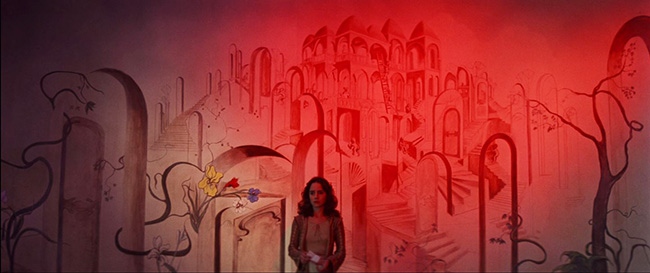
My memory of first watching Suspiria (1977) is as vivid as the film’s famous colors. It was in a theater in Salt Lake City, proudly subverting the city’s conservative culture with regular midnight movie screenings, The Rocky Horror Picture Show included. Most of what I knew about Suspiria came from a brief description in the Leonard Maltin Movie Guide; I had never seen a film by Dario Argento, and as I took a seat in the mostly-empty theater to watch their latest cult offering I had no idea what to expect. It was an old, scratched-up print, but the sound was cranked all the way up. As Suspiria fans know, this is vital. I was immediately sucked into the plight of American Suzy Bannion (Jessica Harper, Phantom of the Paradise) as she stumbles out of a German airport, past a travel poster advertising the Black Forest with the ominous image of dark trees, and then takes a taxi into a literal Black Forest amidst a downpour and flashes of lightning, all while Goblin’s iconic soundtrack slices like a knife. When the first murder occurs, a series of inexplicable, illogical assaults culminating in a death that might as well be an art installation, I was both shocked (again – I had not seen any Argento before) and oddly exhilarated. The climax, a spine-tingling confrontation with the ageless witch Helena Markos, the Mother of Sighs, had me holding my breath. The film is still potent, but never as much as that first time – I’ve seen the film projected twice since then in different prints, and watched more Argento, more Italian horror and giallo in general, and been exposed to more of Goblin’s prog rock freakouts; and of course the film’s surprises are mostly exhausted. Yet the film’s colors have not faded. Thanks to a new 4K restoration from Synapse Films in collaboration with the film’s director of photography Luciano Tovoli, now available in a limited edition Blu-ray steelbook*, they are as bright and hypnotic as ever.
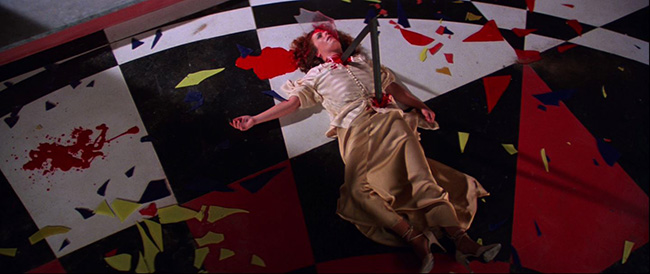
Precisely composed slaughter.
The restoration is incredibly satisfying to watch, the blues, reds, and greens staining the corridors and dormitories of Freiburg’s Tanz Dance Academy from all angles, reinforcing the dream qualities of Argento’s film. Available in the disc’s audio options, and utilized in theatrical screenings of this restoration, is the original 4.0 surround mix which played in select cities during the film’s initial run; this mix contains subtle but unique differences which one can obsess over just as Beatles fans delve into the differences between Sgt. Pepper stereo and mono. But most viewers will just submit themselves to the aggressive Goblin score, which doesn’t so much immerse you in the film’s world as seize you by the ears and drag you inside. The music ranks among the most memorable soundtracks of all time, so inseparable from the images that I still can’t forget the absurdity of watching live while a Russian synchronized swimming duet performed in the 2012 Olympics to Suspiria‘s main title music. So overwhelming are the film’s aesthetics that it’s often offered as an example of style over substance, the sights and sounds disguising an illogical plot and making more excusable the hammier aspects of 70’s Italian moviemaking, dubbing (by necessity, given the airplanes flying over the studio) and some overacting included. The criticism is both completely valid and largely unimportant. Argento’s exuberant filmmaking, applying meticulous craftsmanship to composition and elaborately choreographed sequences, often dashes headlong into the ridiculous; the fact that his style has become more slack in the past decade-plus only exaggerates his weaknesses. But one of the key elements to Suspiria‘s effectiveness is the screenplay’s co-writer Daria Nicolodi, an actress in films like Argento’s stellar Deep Red (1975) (and the mother of Asia Argento). Nicolodi developed the story, drawing from an anecdote told to her by her grandmother about an acting academy she attended where the teachers were practicing black magic. Taking additional inspiration from Thomas de Quincey’s Suspiria de Profundis and its opium-dream essay “Levana and Our Ladies of Sorrow,” Nicolodi guides Argento away from giallo thrillers and into the realms of fever dream and fairy tale. Who cares about logic?
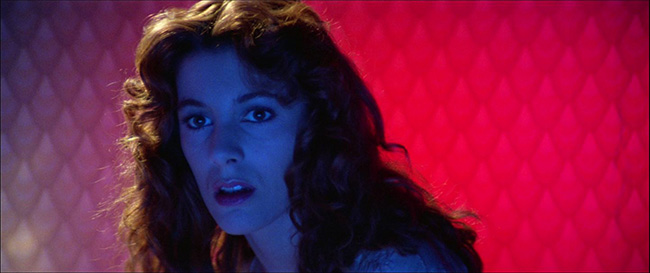
Stefania Casini as Suzy’s roommate Sara.
Beginning with the poster advertising the Black Forest, Argento pushes imagery and themes that reinforce Suspiria as a tale passed down from a grandmother delighting in spooking a child. When dance student Pat (Eva Axén) flees the school late at night, runs through a forest in a storm and takes shelter in a friend’s apartment, note the shot where Argento frames the wallpaper of birds as though they are pursuing her (she flinches in the opposite direction); they become, in the mise en scène, the familiars of a witch on the chase. The school’s corridors lead to doors that are just a bit too tall, the handles raised so that Suzy and her roommate Sara (Stafania Casini, 1900) have to reach to open them, essentially making them children. One important door is above a ramp, distorted like something out of The Cabinet of Dr. Caligari, and when Suzy finally deciphers the film’s central riddle and learns how to open a secret door into the coven’s domain, the portal is smaller than it should be, Suzy bending down like Alice squeezing into Wonderland. One of the few scenes that is not bathed in impressionistic colors and lighting is the requisite visit to the Experts Who Explain Everything, a daylit, outdoors encounter with two professors (Rudolf Schündler from The Exorcist and ubiquitous cult favorite Udo Kier) who explain the history of witchcraft and a sinister figure known as the Black Queen (which might as well be another Alice in Wonderland reference, if not a nod to the sinister queens in fairy tales). After this stretch of sobriety, we’re plunged right back into the dreamworld of the Tanz Academy and the thrall of Miss Tanner (Alida Valli, The Third Man) and Madame Blanc (Joan Bennett, Father of the Bride).
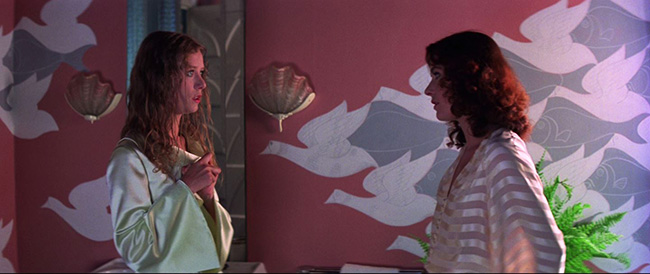
Pat Hingle (Eva Axén), chased by birds in the wallpaper.
Suzy trips and sways through this world in a state of half-waking: when she’s not drugged at night by a tainted drink, she’s targeted by hexes. As Jessica Harper related during a post-screening Q&A at this year’s Cinepocalypse Festival in Chicago, most of her fellow actors were delivering their lines in Italian, which left her waiting for a pause to act as a cue. But somehow that works for Suzy Bannion. In watching the Blu-ray last night, I was struck by how much the story’s effectiveness depends upon the character’s complete isolation. From her request to the airport’s taxi driver to help her with her luggage (he doesn’t), to the way she’s immediately characterized by Miss Tanner and Madame Blanc as stubborn and strong-willed by asking simple questions or making basic requests about her lodging, or the crude hazing she receives from a fellow student, Olga (Barbara Magnolfi), Suzy is constantly reminded that she is an other in this place. She lucks into an ally with her roommate Sara, the only person curious about Pat’s death, and who also provides helpful clues as to the mysterious nature of the faculty; naturally we become invested in their relationship. Harper is excellent, grounding the action with her alternately skeptical and appropriately baffled performance, and Argento’s camera makes the most of her large, Silent Movie Star eyes, which dart back and forth as she ponders the academy’s mysteries.
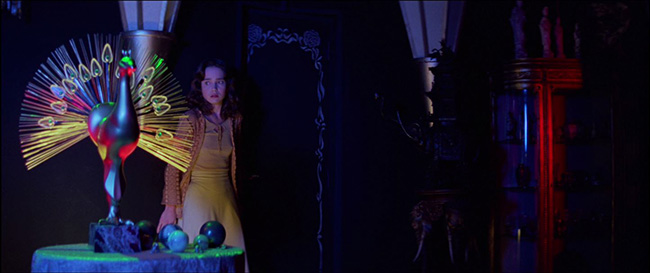
Suzy Bannion (Jessica Harper) penetrates the supernatural heart of the Tanz Dance Academy.
But Argento never lets us relax; he frequently throws the viewer off-kilter with images that sting. Like the flash of light – a sinister spell – that blinds Suzy as she walks past the kitchen and a member of the school’s staff; her son, a blond Little Lord Fauntleroy, suddenly grins hideously in that one eerie shot. Or eyes that blaze out from a dark window. Or the unexpected revelation of a room full of barbed wire. The way his camera lingers with fetishism on tableaus both trivial and gruesome lends them occult meaning: the blood on the floor beneath the hanged Pat is splattered into a Rorschach shape that invites interpretation. Before a blind man is attacked by his possessed guide dog, Argento keeps showing us a stone eagle on a rooftop as though it might come to life like in Burn, Witch, Burn (Night of the Eagle, 1962), and then mimics its descent with the sound of flapping wings – what becomes a fake-out, but retains the residue of something supernatural that transpired, an indecipherable but critical element in the spell. Entire murder scenes transpire with disconnected ideas as sharp as broken glass. Suspiria, like a story told by a mischievous grandmother, is all about sensation and fear, not facts. In the finale, why can Suzy be glimpsed smiling as she stumbles away from a building which has just imploded like the House of Usher? For the same reason that we smile after screaming for the duration of a rollercoaster ride.
*Pre-orders went up in August and began shipping late last week. Limited to 6,000 units, the Suspiria steelbook (which also includes a bonus disc of special features, a soundtrack CD, and an “O-card” which slips over the steelbook to present the original theatrical poster) is rapidly selling out as of this writing. However, it’s widely expected that a standard edition will become available from Synapse Films in the near future.










